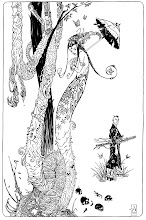I am not even sure what I can say about this story...other than the fact that if I would total all the time I have spent reading/looking/copying each page it would probably be days.

"The Vanities of Philip Whitehead" by Sandy Plunkett (inked by Scott Hampton)
Another story that impacted my understanding of comics. This is a straight up heroic story and is an artistic tour de force from a classically inclined artist. Wonderful storytelling and rendering throughout.

I have been fortunate to be able to contact Sandy Plunkett and ask him about the story. He was kind enough to jog down a few notes about it and provided a scan of one of the pages as it looked before it got colored:
"Mark Gruenwald gave me this job, though by the time I was half way through the story, the title (Solo Avengers) had fallen into the hands of Greg Wright. Both were great editors to work for- i.e.; they both let me do whatever I wanted. Though I wish one of them had caught the fact that the feminine spelling of Renee has two "e"s.
Anyway. I never got much response from anyone about this story so it's gratifying that Alex has chosen it for this blog. It is a favorite of mine, mostly because I think it manages to tell a fairly satisfying story in very few pages (11). Not easy. To me, it's a study in compressed storytelling. I once heard a movie director (Steven Soderbergh, I think) say that, in his opinion, film making was all about segues, going from one scene to another. I think this is true of all forms of storytelling. The skill with which you make those segues can mean the difference between a bumpy, distracting journey and magic. And a lot can happen in those segues. And if you're writing a story of very limited length, it seems that you have to make full use of that fact. On this page (I consider it my "Gilligan's Island" page- I'd be happy drawing nothing but Gilligan's Island pages for the rest of my life) the top panel on the beach has followed a plane crash-landing in a lagoon. A lot has happens in that interval- the passengers set up camp, got a radio working, etc. We don't see this being done- we drop back into the story at a point when all the activity is completed. A big time saver. But the important jump is to the next panel where we learn that T'challa (ex sp) had separated himself from the group for mysterious reasons. Again, we learn of this after the action has occurred. And by immediately shifting the focus on this aspect of the plot,we bypass a lot of less consequential action that would have been shown in a longer story. The reader is pointed back to the real star of the story (T'challa's friend Philip Whitehead) and the psychoactive plant upon which the plot is hinged. Hopefully, the reader notices none of this machinery.
Sandy"







5 comments:
I don't remember many details of the story (aside from lots of ooze), but I remember loving The Muck Monster in black and white and then hating how it looked colorized. There's a compilation coming in October-ish, which I hope doesn't repeat that mistake.
I remember seeing Sandy Plunkett's name on a Clea backup story and wondering why we didn't see more of him. Gonna look for this Black Panther story.
Edshugeo,
Muck Monster in black/white? I don't think I ever saw that...the only version I know of was published in color. I did see a few of the pages on the web in black and white.
After reading your e-mail I went over on Amazon and found the Bernie Wrightson collection from Dark Horse...pre-ordered!
I'd first read it in an all Bernie Wrightson issue of Creepy, reprints from earlier issues.
Pre-ordered mine back in May along with a couple of cheap blu-rays to get free shipping.
Just got the Bernie Wrightson book in the mail, and was pissed off to find Muck Monster in color. But noticing not many of the other stories that were colorized in the eighties had gotten the same treatment here, and also that Muck Monster didn't look as bad (at all) as I'd remembered, I checked my... digital archives (ahem), and found the first appearance of the story in Eerie #68, in color. Then I looked up the all Bernie issue of Creepy (#113) that I remember from back in the day, and found *that* was in black and white.
In other words, my bad.
Haven't read the book yet, but looking through it, I have no complaints. It's a damn fine looking book.
Alex, thank you so much for choosing this particular story to spotlight on your blog. Sandy Plunkett is a guy that I followed when I was younger and this one, along with a Marvel Fanfare story he did, are both longtime faves. It's terrific reading his thoughts on the tale and its storytelling. Almost like a director's commentary, to borrow his analogy. Sandy's choices for this short story were great!
I highly recommend his artbook, "The World of a Wayward Comic Artist", for those that enjoy classic and heroic images.
Post a Comment